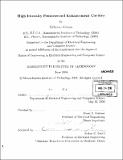| dc.contributor.advisor | Franz X. Kärtner. | en_US |
| dc.contributor.author | Abram, Gilberto | en_US |
| dc.contributor.other | Massachusetts Institute of Technology. Dept. of Electrical Engineering and Computer Science. | en_US |
| dc.date.accessioned | 2011-02-23T14:39:55Z | |
| dc.date.available | 2011-02-23T14:39:55Z | |
| dc.date.copyright | 2009 | en_US |
| dc.date.issued | 2009 | en_US |
| dc.identifier.uri | http://hdl.handle.net/1721.1/61273 | |
| dc.description | Thesis (M. Eng.)--Massachusetts Institute of Technology, Dept. of Electrical Engineering and Computer Science, 2009. | en_US |
| dc.description | Cataloged from PDF version of thesis. | en_US |
| dc.description | Includes bibliographical references (p. 93-94). | en_US |
| dc.description.abstract | To produce extreme ultraviolet radiation via high harmonic generation (HHG) in rare gases, light intensities in excess of 1014 W/cm 2 are required. Usually such high intensity are obtained by parametric amplification of laser pulses, which in turn reduces the pulse repetition rate to a few kHz. Given that the HHG process is inherently inefficient, with conversion ratios less than 10-5, only a small fraction of the pulse energy is lost in the nonlinear interactions, so it is possible to enhance the pulse intensity in a passive cavity retaining the original repetition rate. I present here a novel broadband resonator design which has the potential of supporting intracavity intensities in excess of 1015 W/cm 2 while allowing the harmonic radiation to couple out of the cavity with no loss. Extensive computer simulations are performed with a custom software package, and the required mirrors have been constructed using a standard microfabrication process. | en_US |
| dc.description.statementofresponsibility | by Gilberto Abram. | en_US |
| dc.format.extent | 94 p. | en_US |
| dc.language.iso | eng | en_US |
| dc.publisher | Massachusetts Institute of Technology | en_US |
| dc.rights | M.I.T. theses are protected by
copyright. They may be viewed from this source for any purpose, but
reproduction or distribution in any format is prohibited without written
permission. See provided URL for inquiries about permission. | en_US |
| dc.rights.uri | http://dspace.mit.edu/handle/1721.1/7582 | en_US |
| dc.subject | Electrical Engineering and Computer Science. | en_US |
| dc.title | High intensity femtosecond enhancement cavities | en_US |
| dc.type | Thesis | en_US |
| dc.description.degree | M.Eng. | en_US |
| dc.contributor.department | Massachusetts Institute of Technology. Department of Electrical Engineering and Computer Science | |
| dc.identifier.oclc | 701927042 | en_US |
